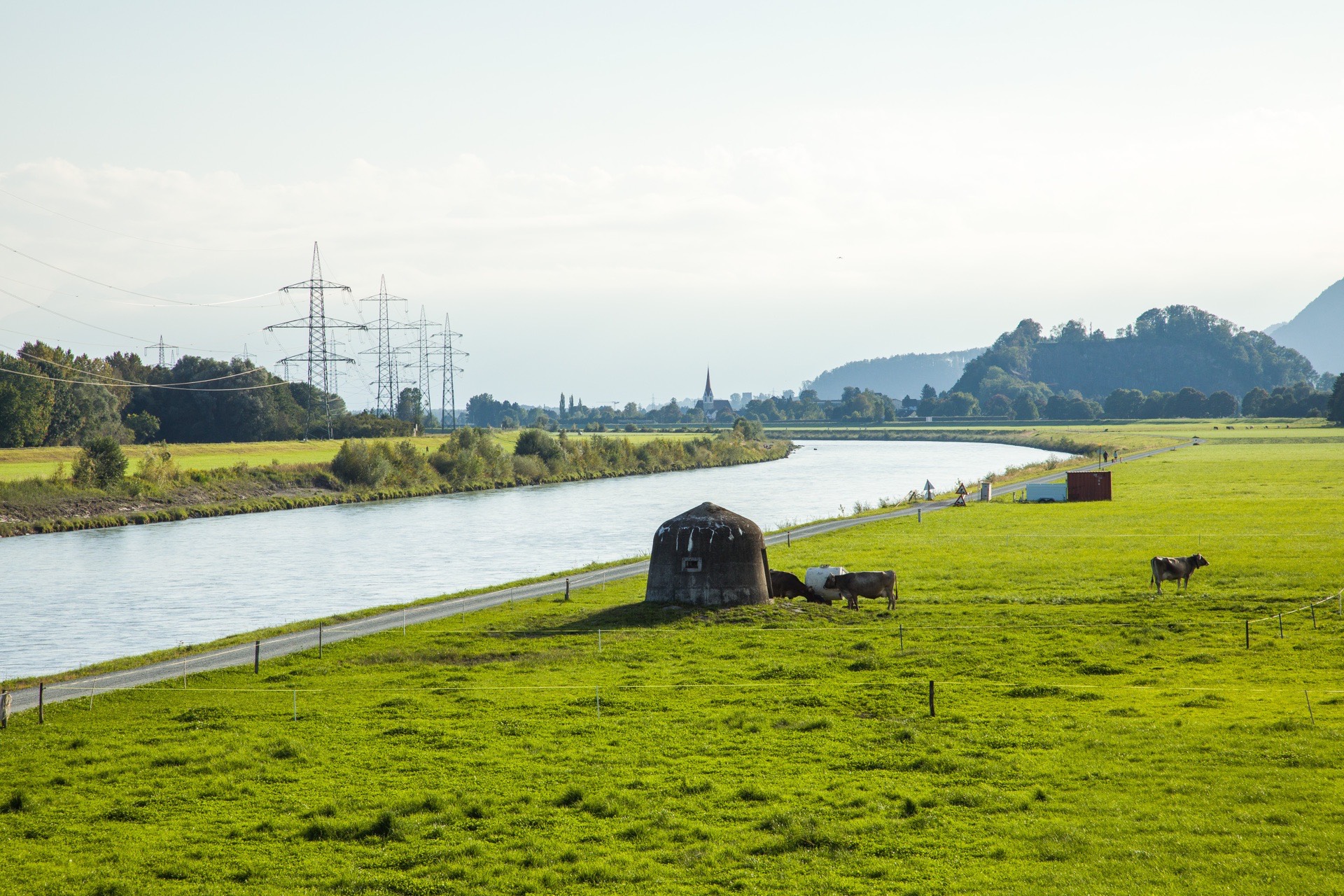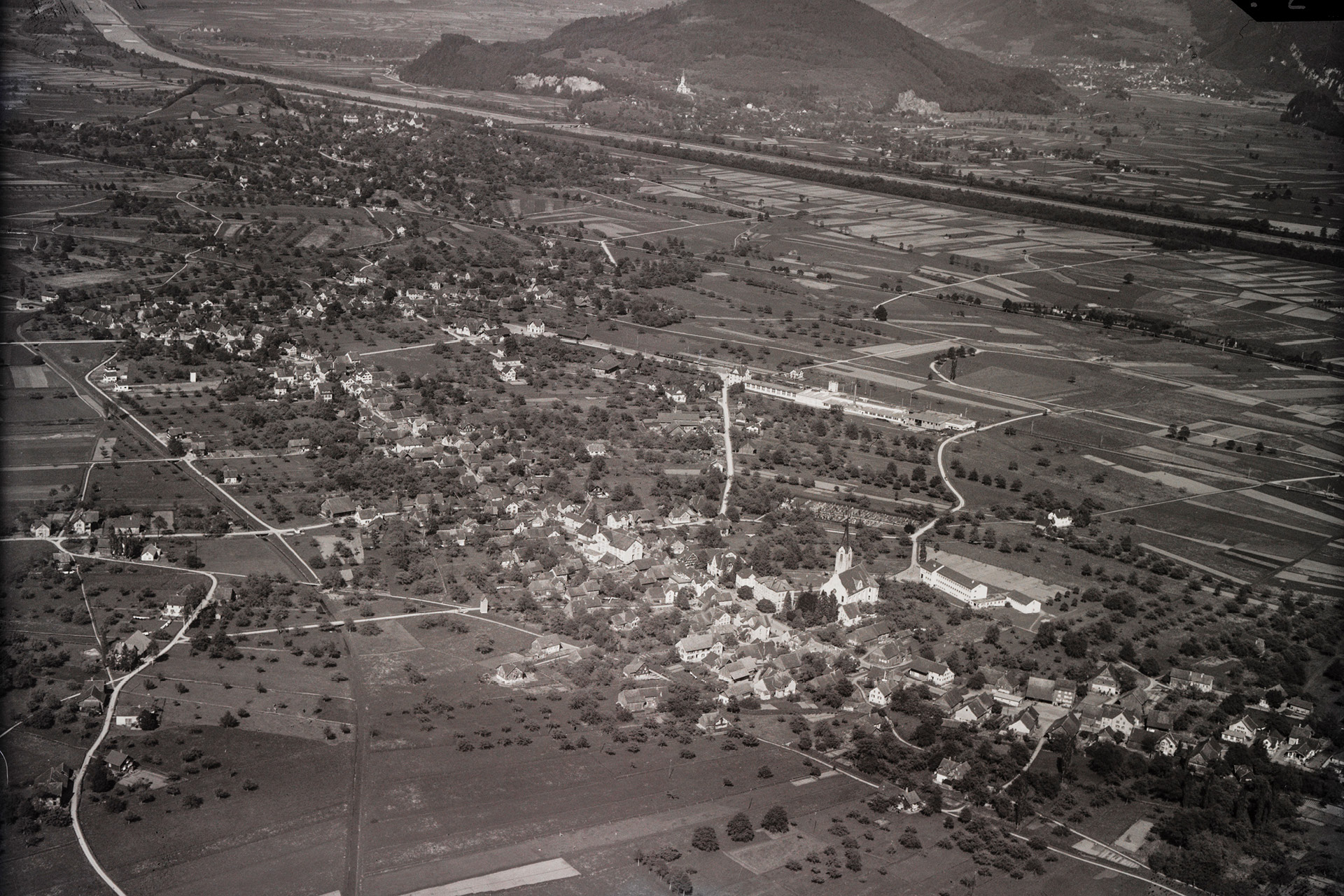Wendel Langenegger> 1940 - 1944
33 Wendel Langenegger
Wendel Langenegger: A Swiss Border Guard Experiences Refugee Fates on the Alpine Rhine
Kriessern - Mäder, 1940 to 1944
Many things that happened at the Rhine border have only been handed down in the memories of contemporary witnesses. One of them was the teacher Wendel Langenegger in the Swiss village Kriessern, directly located on the Rhine opposite the Austrian villages of Koblach and Mäder.
From 1933 to 1940, Langenegger was a teacher in Altstätten, from 1941 to 1950 in Kriessern, then again in Altstätten, and was active as a musician, dialect researcher and local historian. In 1940 he was also deployed as a border guard on the Rhine. In his autobiographical book about his “home village” on the Rhine, Langenegger wrote about various attempts by prisoners of war, forced and foreign laborers to cross the Rhine from Mäder or Koblach.
“In December 1940 I was on guard duty at the Rhine bridge Kriessern-Mäder. (...) In the middle of the night, the alarm signal woke me up from my sleep: ‘Guard commander out!’ Armed with my rifle, I hurried to the Rhine bridge and heard from the darkness the voice of our guard soldier shouting across the Rhine: ‘Don't shoot, they are here!’ Immediately two people rose from the icy cold waters. They had no clothes on, carried only a backpack on their backs and were shivering from the cold. We took them to the customs office, where they were given a warming bath and rations. The rescued, a young Polish doctor and his wife spoke a little German. They told of their months-long flight through Austria to the Rhine. He, a non-swimmer, held on to the woman's backpack as they crossed the Rhine. She had packed an amulet of Czestochowa, a gift from her grandmother, and was firmly convinced that she owed her salvation to Our Lady. The Pole later worked as a camp doctor in a refugee camp in Valais.”[1]
A French refugee also approaches the teacher on guard duty one day from the Rhine, weeping for his apparently drowned friend.
“The escape of the two friends had begun four months ago in Vienna. They had escaped from a prison camp and on the long way to the Rhine border had spent the night only in forests and lonely farmhouses. From the Kummenberg near Koblach, they watched the tour of the German border guards and discussed their escape to Switzerland. They wanted to get through the alder forest to the foreland of the Rhine. There, one of them was supposed to climb into the water and signal the other to follow by throwing a stone. However, the two had been spotted. While the first climbed into the Rhine, a shot rang out behind him. His friend had been shot.”
Until the end of the war, there were repeated attempts to escape across the Rhine even where the stream was a greater obstacle. In December 1944, Langenegger recalls, the body of a man was found on a gravel bank in the Rhine, and his story soon became known on the Swiss side.
“The 36-year-old Pole had worked for almost two years in the Gächter carpentry shop in Koblach (Vorarlberg) to everyone's complete satisfaction. Three weeks before his escape, he met a Polish general who had fought under General Bor in the streets of Warsaw as late as the summer of 1944. This general had been taken prisoner by the Germans and was assigned to forced labor in Koblach. The two compatriots met by chance and decided to escape together. While the general happily reached the saving Swiss shore, his comrade was swept away by the cold floods and met his death. His cries for help were heard by the Swiss border guards, but rescue in the darkness was impossible. His body was found the following day. A student later discovered a bag with the dead man's personal details and some banknotes. Thus ended the life of the young father of a family from Romanowka, Tarnopol District, in Kriessern, in the Rhine Valley of St. Gallen. He found his final resting place in our cemetery. The wooden grave cross soon fell into oblivion. How and when might the news of his death have reached his wife and children in Poland?”
Links:
An audio trail from the quarry to the Rhine follows the traces of forced labor in the region:
Border escape routes in the Foothills of the Rhine. An audio walk on Nazi forced labor, flood protection and escape
[1] Wendel Langenegger, Kriessern – meine Erlebnisse im Heimatdorf und am Rhein. C-Print AG, Au 2003, p. 67-68.
33 Wendel Langenegger
Wendel Langenegger: A Swiss Border Guard Experiences Refugee Fates on the Alpine Rhine
Kriessern - Mäder, 1940 to 1944
Many things that happened at the Rhine border have only been handed down in the memories of contemporary witnesses. One of them was the teacher Wendel Langenegger in the Swiss village Kriessern, directly located on the Rhine opposite the Austrian villages of Koblach and Mäder.
From 1933 to 1940, Langenegger was a teacher in Altstätten, from 1941 to 1950 in Kriessern, then again in Altstätten, and was active as a musician, dialect researcher and local historian. In 1940 he was also deployed as a border guard on the Rhine. In his autobiographical book about his “home village” on the Rhine, Langenegger wrote about various attempts by prisoners of war, forced and foreign laborers to cross the Rhine from Mäder or Koblach.
“In December 1940 I was on guard duty at the Rhine bridge Kriessern-Mäder. (...) In the middle of the night, the alarm signal woke me up from my sleep: ‘Guard commander out!’ Armed with my rifle, I hurried to the Rhine bridge and heard from the darkness the voice of our guard soldier shouting across the Rhine: ‘Don't shoot, they are here!’ Immediately two people rose from the icy cold waters. They had no clothes on, carried only a backpack on their backs and were shivering from the cold. We took them to the customs office, where they were given a warming bath and rations. The rescued, a young Polish doctor and his wife spoke a little German. They told of their months-long flight through Austria to the Rhine. He, a non-swimmer, held on to the woman's backpack as they crossed the Rhine. She had packed an amulet of Czestochowa, a gift from her grandmother, and was firmly convinced that she owed her salvation to Our Lady. The Pole later worked as a camp doctor in a refugee camp in Valais.”[1]
A French refugee also approaches the teacher on guard duty one day from the Rhine, weeping for his apparently drowned friend.
“The escape of the two friends had begun four months ago in Vienna. They had escaped from a prison camp and on the long way to the Rhine border had spent the night only in forests and lonely farmhouses. From the Kummenberg near Koblach, they watched the tour of the German border guards and discussed their escape to Switzerland. They wanted to get through the alder forest to the foreland of the Rhine. There, one of them was supposed to climb into the water and signal the other to follow by throwing a stone. However, the two had been spotted. While the first climbed into the Rhine, a shot rang out behind him. His friend had been shot.”
Until the end of the war, there were repeated attempts to escape across the Rhine even where the stream was a greater obstacle. In December 1944, Langenegger recalls, the body of a man was found on a gravel bank in the Rhine, and his story soon became known on the Swiss side.
“The 36-year-old Pole had worked for almost two years in the Gächter carpentry shop in Koblach (Vorarlberg) to everyone's complete satisfaction. Three weeks before his escape, he met a Polish general who had fought under General Bor in the streets of Warsaw as late as the summer of 1944. This general had been taken prisoner by the Germans and was assigned to forced labor in Koblach. The two compatriots met by chance and decided to escape together. While the general happily reached the saving Swiss shore, his comrade was swept away by the cold floods and met his death. His cries for help were heard by the Swiss border guards, but rescue in the darkness was impossible. His body was found the following day. A student later discovered a bag with the dead man's personal details and some banknotes. Thus ended the life of the young father of a family from Romanowka, Tarnopol District, in Kriessern, in the Rhine Valley of St. Gallen. He found his final resting place in our cemetery. The wooden grave cross soon fell into oblivion. How and when might the news of his death have reached his wife and children in Poland?”
Links:
An audio trail from the quarry to the Rhine follows the traces of forced labor in the region:
Border escape routes in the Foothills of the Rhine. An audio walk on Nazi forced labor, flood protection and escape
[1] Wendel Langenegger, Kriessern – meine Erlebnisse im Heimatdorf und am Rhein. C-Print AG, Au 2003, p. 67-68.



